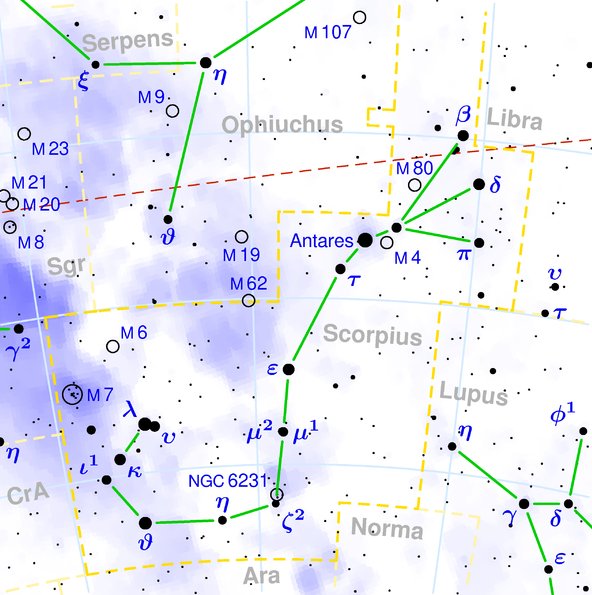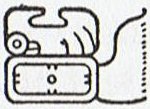Vrischika (π Scorpii) ruled next station:
|
Arab |
Hindu |
Chinese |
|
α Virginis
(Spica) |
Oct 10 (283) |
α Virginis
(Spica) |
Oct 10 (283) |
α Virginis
(Spica) |
Oct 10 (283) |
|
ι (Syrma),
κ, φ Virginis |
Oct 23 (296) |
α Bootis
(Arcturus) |
Oct 22 (295) |
κ Virginis |
Oct 22 (295) |
|
α (Zuben
Elgenubi), β Librae (Zuben Elschemali) |
Oct 31 (304) |
α, β, γ and
ι
Librae |
Oct 31 (304) |
α Librae
(Zuben Elgenubi) |
Oct 31 (304) |
|
Nov 7 (311) |
|
β (Acrab), δ
(Dschubba), π Scorpii (Vrischika) |
Nov 17 (321) |
β, δ, and π
Scorpii |
Nov 17 (321) |
π Scorpii
(Vrischika) |
Nov 17 (321) |

...
Early India knew it
[Scorpius] as Āli, Viçrika, or Vrouchicam,
- in Tamil, Vrishaman; but later on Varāha Mihira said
Kaurpya, and Al Birūni, Kaurba, both from the Greek
Scorpios. On the Cingalese zodiac it was Ussika ...
Taurus was the
Cingalese Urusaba, the early Hindu Vrisha,
Vrishan, or Vrouchabam, - in the Tamil tongue,
Rishabam; but subsequently Varāha Mihira gave it as
Taouri, his rendering of Taurus, and Al Birūni, in his
India, as Tāmbiru.
The connection between Taurus
in spring and Scorpius in autumn probably accounts for the
similarity in names between Vrishabha and Vrishchika. Presumably
it also accounts for the similarity between the figures in Ga1-4
and in Ga7-16:
|
 |
 |
|
Ga1-4 |
Ga7-16 |
Possibly once upon a time Antares (representing
the Scorpion) marked where the rule of Taurus ended.
|
Egyptian sebchet |
 |
Phoenician
pe |
 |
Greek
pi |
Π (π) |
|
Wikipedia: '... according to a theory by
Theodor Nöldeke from 1904, some of the
letter names were changed in Phoenician
from the Proto-Canaanite script ...
pit
'corner' to pe 'mouth' ...'
However, I
think the Egyptian source hieroglyph
could have been Gardiner's O14 (sebchet),
a sign which illustrates a corner
with feather-like ornaments upon the
walls. The meaning was 'portal'
according to Wilkinson. Or why not
an Archway for exit, the Mayas had a
'grasping hand' (Chikin) in
the west:
To be in a corner
means there is no way forward.
|
|
17 |
Anuradha |
β, δ, and π Scorpii |
Triumphal archway,
lotus |
241 = 224
+ 17 |
|
following rādhā |
Vrischika (?) |
Nov 17 (321) |
Number 17 seems to
characterize this lunar station. November 17
could be the end of 17 nights counted from
Zuben Elgenubi. The preceding Visakha
was rādhā which means the pair 16 and
17 should be considered together - of
course necessary in order to count with
both of them together. 16 + 17 = 33 and 16 * 17 =
272 (= 2 * 136).
The Egyptian sebchet
hieroglyph
illustrated a corner in a room and possibly
this explains the idea of a Room in
the Chinese system:
|
1 |
Horn |
α Virginis (Spica) |
Crocodile |
(202.7) |
Oct 10 (283) |
283 = 265
+ 18 |
|
2 |
Neck |
κ Virginis |
Dragon |
(214.8) |
Oct 22 (295) |
295 = 283
+ 12 |
|
3 |
Root |
α Librae (Zuben Elgenubi) |
Badger |
(224.2) |
Oct 31 (304) |
304 = 295
+ 9 |
|
4 |
Room |
π Scorpii (Vrischika) |
Hare |
(241.3) |
Nov 17 (321) |
321 = 304
+ 17 |
Both 4 and 17 were unlucky
numbers. Maybe we should understand 17 as
the sum of 4 and 13.
The Arabs' Iklīl al
Jabhah may have ended 200 days after May
1:
|
0 |
- |
Zero |
η Andromedae |
11.4 |
April 1 (91) |
- |
0 |
|
1 |
Al Sharatain |
Pair of Signs |
β Arietis (Sheratan),
γ (Mesarthim) |
27.4 |
April 17 (107) |
16 |
16 |
| |
|
Musca Borealis |
35 (Head of the Fly), 39
(Kaffaljidhma), and
41 Arietis (Bharani) |
41.4 |
May 1 (121) |
14 |
30 |
|
13 stations |
|
15 |
Iklīl al Jabhah |
Crown of the Forehead |
β (Acrab), δ (Dschubba),
π Scorpii (Vrischika) |
241.3 |
Nov 17 (321) |
10 |
230 |
|
13 stations |
Number 17 was here
changed into 10 because of the
insertion of Zuben Elschemali (β
Librae). Possibly the Crown of the
Forehead could allude to Corona
Borealis.
In C we will then expect a
glyph at heliacal November 17 (321) to represent
Vrischika. 321 - 80 = 241:
|
November 14 |
15 |
16 |
17 (321) |
18 |
19 |
 |
 |
 |
 |
 |
 |
|
Cb9-12 (604) |
Cb9-13 |
Cb9-14 |
Cb9-15 |
Cb9-16 |
Cb9-17 |
|
te
maitaki - ka hua roa |
te
maitaki - oho te vae |
te
inoino |
oho te vae |
e
inoino |
oho te
vae |
|
γ Cor. Borealis
(237.7), Unuk Elhaia
(237.9), π Cor.
Borealis, Cor Serpentis
(238.1) |
Chow (238.6), κ
Serpentis (239.3), δ
Cor. Borealis, Tiānrǔ
(239.5) |
χ Lupi, (239.6), ω
Serpentis (239.7), Ba, χ
Herculis (239.8). κ Cor.
Borealis, ρ Serpentis
(239.9), β Tr. Austr.
(240.3), κ Tr. Austr.
(240.4) |
Iklīl al Jabhah-15 /
Anuradha-17 /
Room-4 |
Dschubba
(241.7), η Lupi (241.9),
υ Herculis (242.3), ρ
Cor. Borealis (242.4) |
ι Cor. Borealis (242.5),
ξ Scorpii (242.7),
Acrab,
Jabhat al Akrab (243.3),
θ Lupi, Rutilicus
(243.5) |
|
ρ Scorpii (240.8), ξ
Lupi, λ Cor. Borealis
(241.1), Zheng (241.2),
VRISCHIKA (241.3),
ε Cor. Borealis (241.5) |
Schedir 687 |
|
May 15 |
16 (136) |
17 |
18 |
19 |
20 |
|
Atiks, Rana (55.1),
Celaeno, Electra,
Taygeta (55.3) |
Al
Thurayya-27 / Krittikā-3
/
Hairy Head-18 |
no star listed |
Menkhib (57.6) |
Zaurak (58.9), λ Tauri
(59.3) |
ν Tauri (59.9) |
|
TAU-ONO |
Porrima 502 |
Cor Caroli 505 |
Metoro said
oho te vae and oho
means to go away (leave, depart), which agrees with my
ideas about the meaning of π -
marking where half a circle is
completed. Menkhib (ζ
Persei) was probably a
sign of the opposite, a place
for
rebirth:

|
Egyptian eye |
 |
Phoenician ayin |
 |
Greek omicron |
Ο (ο) |
|
... The
letter name is derived from
Proto-Semitic
*‘ayn-,
eye, and the Phoenician letter had an
eye-shape, ultimately derived from the
jr hieroglyph ... To this day,
‘ayin in Hebrew,
Arabic and Maltese means 'eye' and
'spring' (‘ayno
in Neo-Aramaic). |
607 (Cb9-15) -
107 (April 17) = 500 = 365 + 135
(May 15 when in rongorongo times
Tau-ono rose with the
Sun).
607 - 393 = 214
and 107 (Cb1-1) + 214 = 321
(November 17).
289 (October 16)
+ 214 (= 2 * 107) = 503 = 365 +
138 (May 18). From May 18
written as 5-18 we could then
count 51 * 8 = 408 (=
300 + 108).
|
Oho
1. To
go: ka-oho!
go! go away! (i.e.
'goodbye' said by
the person staying
behind);
ka-oho-mai (very
often contracted to:
koho-mai),
welcome! (lit.: come
here); ku-oho-á
te tagata, the
man has gone.
Ohoga, travel,
direction of a
journey;
ohoga-mai,
return. 2. Also
rauoho, hair.
Vanaga.
1.
To delegate; rava
oho, to root. 2.
To go, to keep on
going, to walk, to
depart, to retire;
ka oho,
begone, good-bye;
oho amua, to
preced; oho mai,
to come, to bring;
oho arurua,
to sail as consorts;
hakaoho, to
send, a messenger.
3. Tehe oho te
ikapotu, to
abut, adjoin; mei
nei tehe i oho mai
ai inei te ikapotu,
as far as, to;
kai oho, to
abstain, to forego;
hakaoho, to
put on the brakes.
4. The head (only in
the composite
rauoho, hair).
Churchill. |
|
Vae
Va'e: Foot, leg;
te va'e mata'u,
te va'e maúi,
right foot, left
foot. Va'e ruga,
va'e raro, quick
and light, without
detour (lit.: foot
up, foot down).
Ka-oho koe ki a nua
era va'e ruga va'e
raro, ina ekó
hipa-hipa, hurry
straight to your
mother, do not make
any detours. Va'e
pau, misshapen
foot, clubfoot.
Vae, to choose.
Vaega,
middle, centre; i
vaega o, in the
middle of. Vanaga.
1.
Foot, paw, leg,
limb; vae no roto,
drawers; karikari
vae, ankle. P
Pau.: vaevae,
foot, leg. Mgv.:
vaevae, id. Mq.:
vae, id. Ta.:
vaevae,
avae, id. 2.
Pupil. 3. To choose,
elect, prefer,
promote, vote;
vavae, to
destine, to choose;
vaea (vae
2), pupil.
Vaeahatu (vae
1 - ahatu):
moe vaeahatu,
to sleep sprawling
with legs extended.
Vaega,
center, middle,
within, half; o
vaega, younger;
ki vaega,
among, between,
intermediate. P
Pau.: vaega,
the middle. Mgv.:
vaega, center,
middle. Mq.:
vaena, vavena,
vaveha, id.
Ta.: vaehaa,
half. Vaehakaroa
(vae 1 -
roa): moe
vaehakaroa, to
sleep with legs
stretched out.
Vaehau (vae
1 - hau 3),
pantaloons,
trousers.
Vaeherehere (vae
1 - here 1),
to attach by the
paw. Vaerere
(vae 1 -
rere 1), to run.
Churchill.
Ta.: 1. Timbers of a
boat. Ha.: wae,
knees, side timbers
of a boat. 2. To
share out. Sa.:
vae, to divide,
to share. Ma.:
wawae, to
divide. Churchill. |
Why are
there 3 vae glyphs?
Possibly to indicate the
equation
3 * 107 = 321 (November 17).
|




